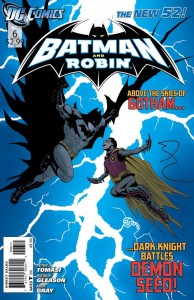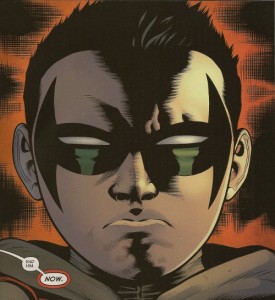 EDITOR’S NOTE: Vowing upon their parents’ death to rid Gotham City of the forewarning element, Crisis On Infinite Midlives has, over the years, fought spoilers in their many macabre forms. This time they lost. You are warned.
EDITOR’S NOTE: Vowing upon their parents’ death to rid Gotham City of the forewarning element, Crisis On Infinite Midlives has, over the years, fought spoilers in their many macabre forms. This time they lost. You are warned.
As I said in my review of Batman & Robin #4, I am enjoying this book one hell of a lot more than I thought I was going to when I finished the first issue. A book that started out looking like the worst of the Batman TV show was starting to look more like the Christopher Nolan movies. And #6 continues that trend, but there’s a funny thing about movies: I’ve always said (Because I lifted it from Stephen King in Danse Macabre) that I can tell if a movie’s any good, or if it’s too long, if I start wishing for a cigarette in the middle of it. At six issues into this battle against new villain Nobody? Yeah, I could use a smoke.
It’s not that this is a bad story by any stretch of the imagination. This issue gives us Robin under the clandestine tutelage of Nobody, who is actually Morgan Ducard, son of Henri Ducard, who trained Bruce Wayne before he put on the Batman suit. You remember, Liam Neeson from Batman Begins? You know, that Batman movie just before The Dark Knight? The one with the chick who’s banging Tom Cruise? Just go to any Best Buy dollar DVD bin and you’ll find it. But I digress.
Nobody is slowly massaging Robin into becoming a killer, starting to ease Robin toward a willingness to kill by doing the old “give him an empty gun and tell him to shoot a guy to get him used to pulling the trigger” trick, followed a couple of pages later with the subtle mindfuckery of the “Now dump the guy into a vat of acid while he’s awake and screaming like a pig in a chute” ruse. In the meantime, we flash back to Bruce’s first mission with Nobody’s father, where he tried a similar method of attenuating Bruce toward lethal means with the time-tested classic, “Shoot a dude in the face in front of the guy who has repeatedly stated that he will never kill, then say, ‘U mad bro?'” The two stories are interesting and effective in drawing parallels between Batman’s early training and Robin’s current work, but the abrupt nature of each Ducard suddenly chucking in lethal force is jarring, and forced me to say, “Oh well; he only had about about 20 pages to get it done,” and just like when you realize you’ve started looking for the wires in a space opera movie, boom! Just like that, you’re out of the story and wishing for a cigarette.
And while this story arc has turned into a much more intense and entertaining read than I could have anticipated when I saw Batman and Robin sliding down Batpoles, this is issue six. And considering that most many trade paperbacks reprint an even number of issues, that means we have two more issues before we get a resolution to this story (Confirmed by DC’s April solicitations for the book), and that is fucking decompressed. From a total page count point of view, that puts this story in line with The Dark Knight Returns, and while it’s better than I thought it was going to be, it didn’t need to be eight months long. Hell, Pulp Fiction is my favorite movie, and even watching that I start jonesing for a butt by about the time Bruce Willis says, “Zed’s dead.” At six months into Batman & Robin with two more to go, I’m about ready to start smoking rope.
 Patrick Gleason’s art remains consistent with previous issues of this book, but he made a choice on this book that really caused me problems right out of the gate: Robin’s face. The first page of the book is a splash close-up of Robin’s face… and it is round. Like, almost a perfect circle round; no chin, no cheekbones, just a push off the wall from requiring all the king’s horse’s and all the thing’s men. Which is a unique look, but when you put it right in the reader’s face immediately upon opening the book, it made me start looking at every panel with Robin to see if he had any facial features whatsovever. And that isn’t the end of the world, but it caused me to notice in a later close-up that Gleason had drawn Robin’s eyebrows on top of his mask. But otherwise, the art remains stylized-cartoony, with a few stellar action panels of Batman in motion (Yes, Batman has a chin) and some good general action sequences and clear storytelling… but those few moments of heavy stylizing caused me to spend the rest of the book, again, looking for the wires instead of the story.
Patrick Gleason’s art remains consistent with previous issues of this book, but he made a choice on this book that really caused me problems right out of the gate: Robin’s face. The first page of the book is a splash close-up of Robin’s face… and it is round. Like, almost a perfect circle round; no chin, no cheekbones, just a push off the wall from requiring all the king’s horse’s and all the thing’s men. Which is a unique look, but when you put it right in the reader’s face immediately upon opening the book, it made me start looking at every panel with Robin to see if he had any facial features whatsovever. And that isn’t the end of the world, but it caused me to notice in a later close-up that Gleason had drawn Robin’s eyebrows on top of his mask. But otherwise, the art remains stylized-cartoony, with a few stellar action panels of Batman in motion (Yes, Batman has a chin) and some good general action sequences and clear storytelling… but those few moments of heavy stylizing caused me to spend the rest of the book, again, looking for the wires instead of the story.
In general, Batman & Robin remains a book worth reading, and vastly better than I would have thought in first read of the first issue. But eight issues is a long time to keep a comic book story on the percolator, and this particular issue, even just being a part of a giant story, felt rushed. Writer Peter Tomasi’s ramming of the parallels between Bruce and Damian’s early training into twenty pages – three of which are full-page splashes – felt forced, and therefore not as powerful as it could have been. This is still a good comic book, but one that tries to do too much with too little space, making the whole thing feel like a not-very-essential part of what is turning out to be a giant story.
I guess what I’m saying is: if you need a smoke break from this arc? Make it this issue.
 Podcast RSS Feed
Podcast RSS Feed iTunes
iTunes Google Play
Google Play Stitcher
Stitcher TuneIn Radio
TuneIn Radio Android
Android Miro Media Player
Miro Media Player Comics Podcast Network
Comics Podcast Network